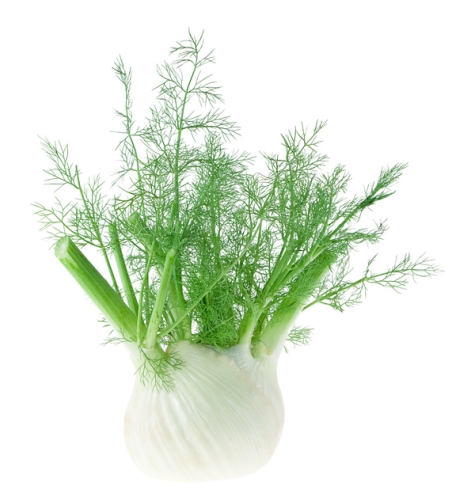One of the philosophies I espouse is "You have to eat, so why not learn to cook and eat well?" That said, I like to experiment with new foods.
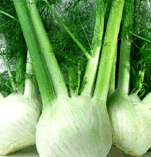 That brings me to fennel—for me a new food. It has always been that mystery plant that I'd spy in so many farmers' markets towards the end of every summer. In fact, it'll be at it's height in the next month or so, so if you haven't discovered the unique flavor this delicious spice adds to cooking, it's time to give it a try.
That brings me to fennel—for me a new food. It has always been that mystery plant that I'd spy in so many farmers' markets towards the end of every summer. In fact, it'll be at it's height in the next month or so, so if you haven't discovered the unique flavor this delicious spice adds to cooking, it's time to give it a try.
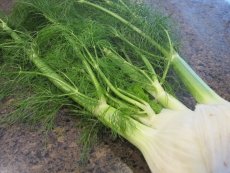 Fennel is composed of a white or pale green bulb from which closely superimposed stalks are arranged. The stalks are topped with feathery green leaves near which flowers grow and produce fennel seeds. The bulb, stalk, leaves and seeds are all edible. Fennel belongs is closely related to parsley, carrots, dill and coriander. Fennel contains its own unique combination of phytonutrients—including the flavonoids rutin, quercitin, and various kaempferol glycosides—that give it strong antioxidant activity.
Fennel is composed of a white or pale green bulb from which closely superimposed stalks are arranged. The stalks are topped with feathery green leaves near which flowers grow and produce fennel seeds. The bulb, stalk, leaves and seeds are all edible. Fennel belongs is closely related to parsley, carrots, dill and coriander. Fennel contains its own unique combination of phytonutrients—including the flavonoids rutin, quercitin, and various kaempferol glycosides—that give it strong antioxidant activity.
Its most fascinating phytonutrient compound may be anethole—the primary component of its volatile oil. The anethole in fennel reduces inflammation and helps prevent the occurrence of cancer. Researchers discovered that anethole is involved in the shutting down of an intercellular signaling system called tumor necrosis factor (or TNF)—mediated signaling. By shutting down this signaling process, the anethole in fennel prevents activation of a potentially strong gene-altering and inflammation-triggering molecule called NF-kappaB. The volatile oil has also been shown to protect the liver from toxic chemical injury.
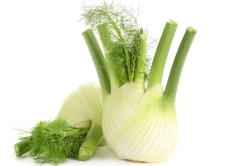 In addition to its unusual phytonutrients, fennel bulb is an excellent source of vitamin C, which neutralizes free radicals in all aqueous (water-related) environments of the body. If left unchecked, these free radicals cause cellular damage that results in the pain and joint deterioration that occurs in conditions like osteoarthritis and rheumatoid arthritis.
In addition to its unusual phytonutrients, fennel bulb is an excellent source of vitamin C, which neutralizes free radicals in all aqueous (water-related) environments of the body. If left unchecked, these free radicals cause cellular damage that results in the pain and joint deterioration that occurs in conditions like osteoarthritis and rheumatoid arthritis.
And the last bit of science: Fennel is a great source of fiber and also helps reduce elevated cholesterol levels and is useful in preventing colon cancer. In addition to its fiber, fennel is a very good source of folate, a B vitamin, and potassium.
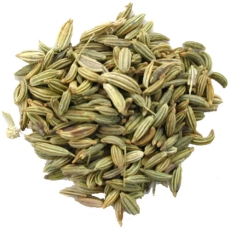 But the mystery still remains: what do you DO with this powerfully healthy plant? As mentioned above, fennel is considered a spice: the seeds add a unique and delicious flavor to tuna casserole, for instance. But there's so much more to it. Fennel bulb and leaves are considered a vegetable—one of the most underutilized vegetables I can think of.
But the mystery still remains: what do you DO with this powerfully healthy plant? As mentioned above, fennel is considered a spice: the seeds add a unique and delicious flavor to tuna casserole, for instance. But there's so much more to it. Fennel bulb and leaves are considered a vegetable—one of the most underutilized vegetables I can think of.
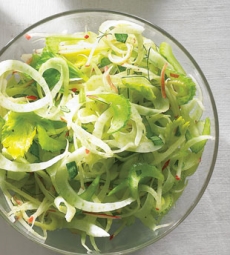 When raw, the texture of fennel is cold and crisp. Take advantage of the refreshing crispness by thinly slicing the bulb into salads or slaws. When caramelized, fennel tastes almost like licorice candy, and it acts as a wonderful flavor base as part of a mire poix, lending dishes an "I can't quite figure out what that flavor is, but man is it good quality!" Fennel is also very tasty on its own, sautéed, or even grilled.
When raw, the texture of fennel is cold and crisp. Take advantage of the refreshing crispness by thinly slicing the bulb into salads or slaws. When caramelized, fennel tastes almost like licorice candy, and it acts as a wonderful flavor base as part of a mire poix, lending dishes an "I can't quite figure out what that flavor is, but man is it good quality!" Fennel is also very tasty on its own, sautéed, or even grilled.
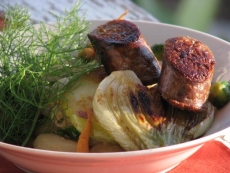 Fennel leaves (fronds) can be chopped up and used to flavor any number of dishes, either hot or cold, much like you would use any other culinary herb. Use it in dishes that also feature citrus, or in any dish that reminds you of spring. Of course, these fronds also make a beautiful, feathery garnish for dishes containing fennel. Fennel seeds are one of the primary spices in Italian sausage, and they are also used frequently in Indian and Middle Eastern cuisine. It has a very concentrated, musky-anise aroma and flavor. A little fennel goes a long way, but if you are a fan of this plant and can get your hands on it, mix some into a cream sauce, use it as part of a dry spice rub, toss it into a casserole, or add it to a soup or chowder.
Fennel leaves (fronds) can be chopped up and used to flavor any number of dishes, either hot or cold, much like you would use any other culinary herb. Use it in dishes that also feature citrus, or in any dish that reminds you of spring. Of course, these fronds also make a beautiful, feathery garnish for dishes containing fennel. Fennel seeds are one of the primary spices in Italian sausage, and they are also used frequently in Indian and Middle Eastern cuisine. It has a very concentrated, musky-anise aroma and flavor. A little fennel goes a long way, but if you are a fan of this plant and can get your hands on it, mix some into a cream sauce, use it as part of a dry spice rub, toss it into a casserole, or add it to a soup or chowder.
Besides not knowing what to do with fennel, I also didn't have a clue as to how to cut this plant. This mystery was solved when I found this wonderful pictorial tutorial in an old issue of a Bon Appetit magazine.
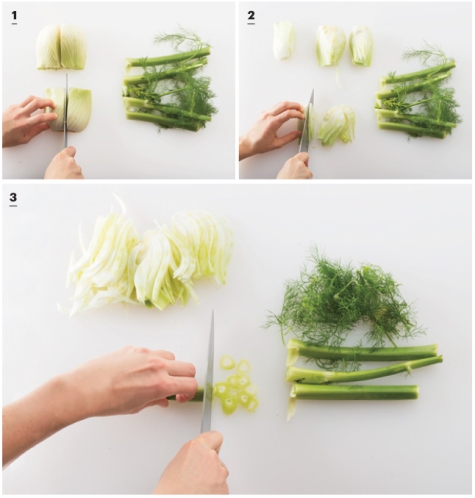
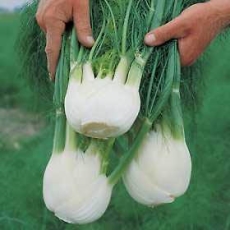 The bottom line to my fennel research and experimenting is that it can be used in all sorts of things without messing up a recipe. So just find it and start using it—you won't be sorry. Considering fennel's taste, super versatility, and health benefits, this wonderful plant should no longer remain a mystery!
The bottom line to my fennel research and experimenting is that it can be used in all sorts of things without messing up a recipe. So just find it and start using it—you won't be sorry. Considering fennel's taste, super versatility, and health benefits, this wonderful plant should no longer remain a mystery!
- www.photo-dictionary.com
- www.whfoods.com
- www.bringingeuropehome.com
- www.deandeluca.com
- www.bonapetit.com
- www.whatcom.wsu.edu

Alice Osborne
Weekly Newsletter Contributer since 2006

